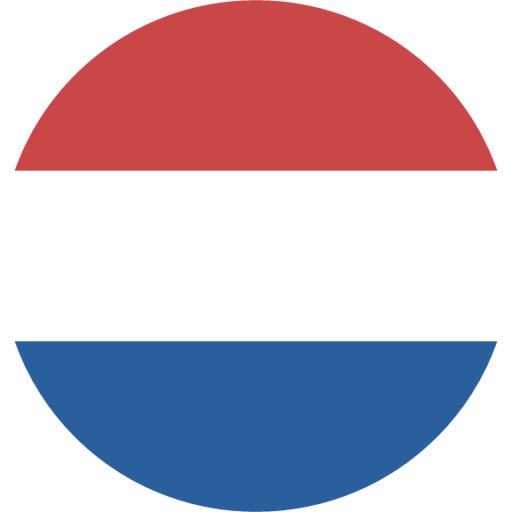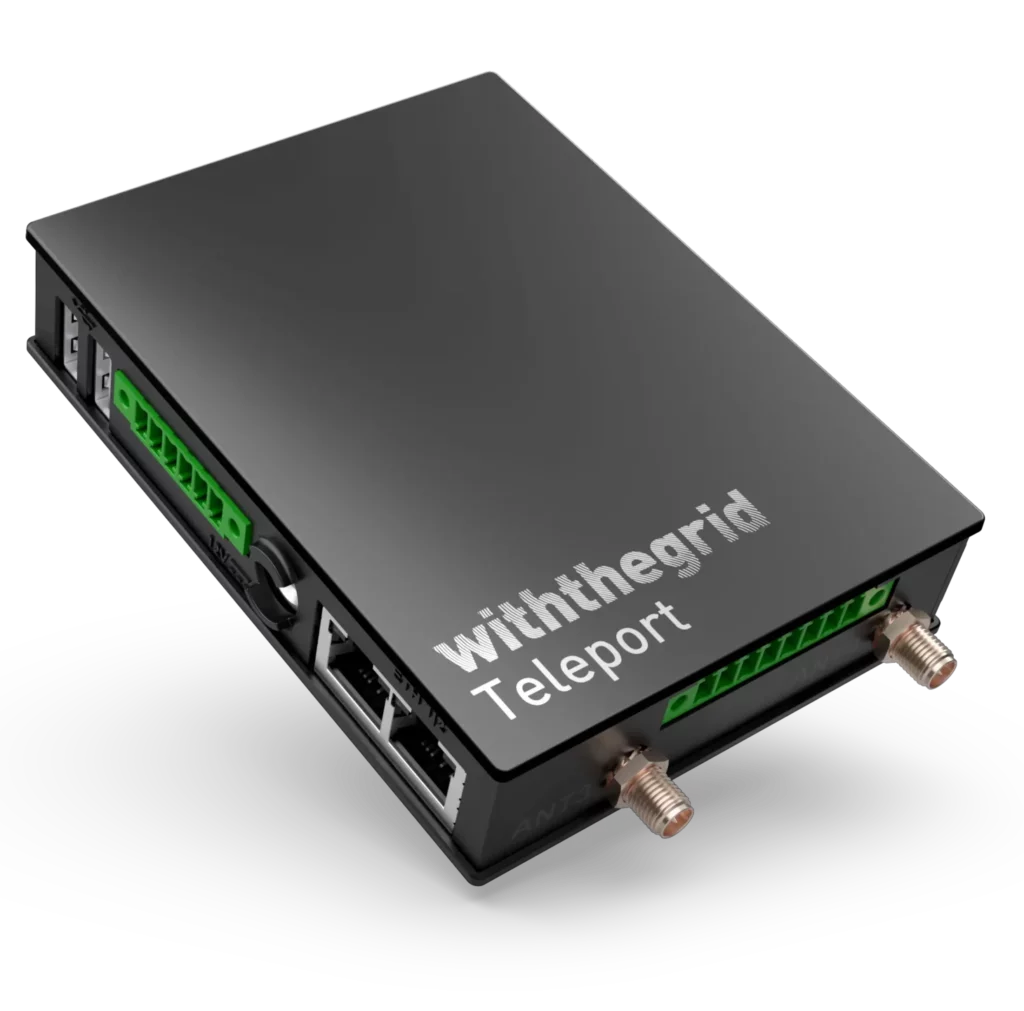Home → Blog → Energy concepts → Energy hubs explained: definition, how it works, why it matters
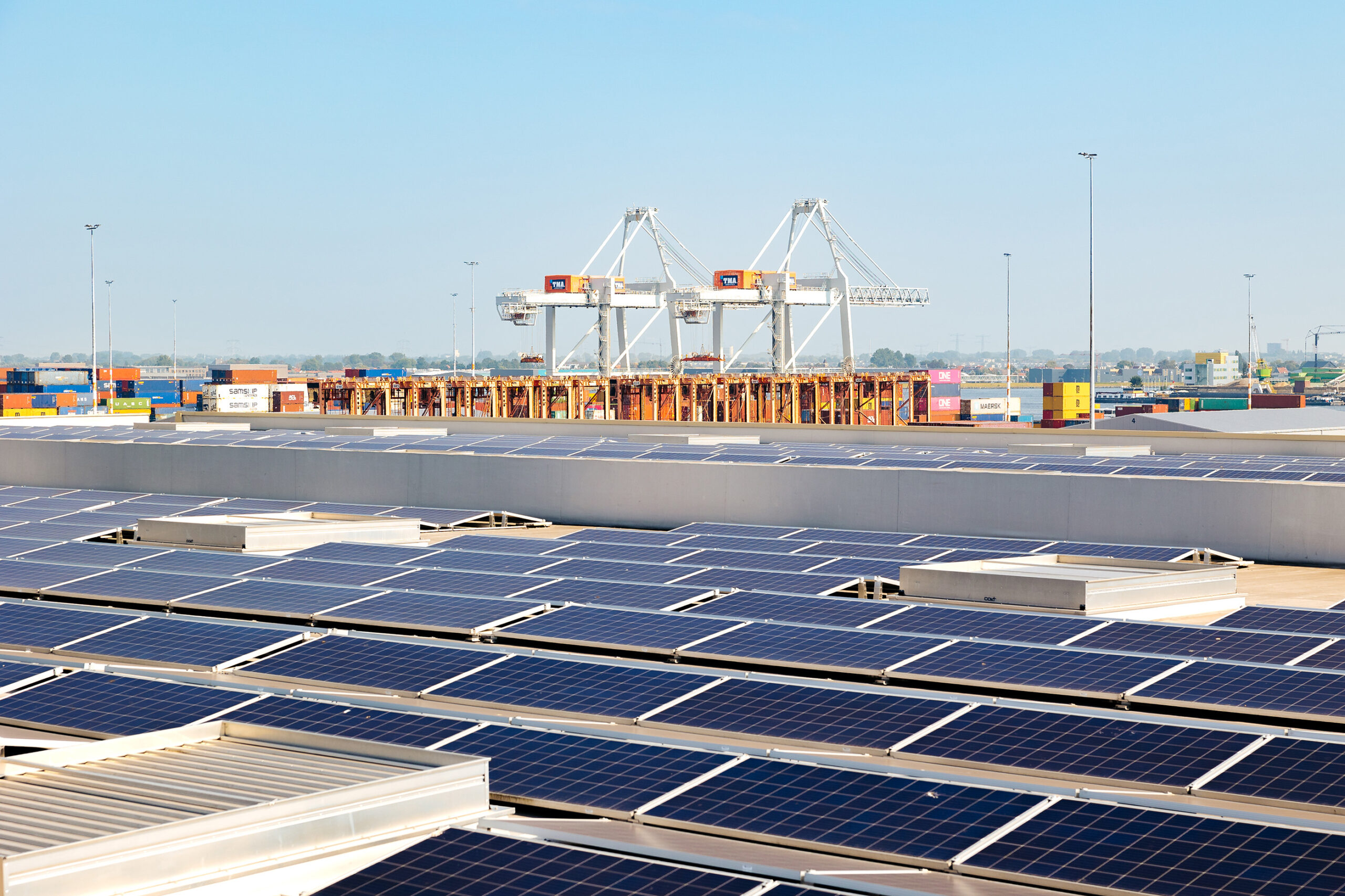
By
Anaïs Wampack
Published on:
21/08/2024
A special thanks to Marien Boonman for his contribution on this article.
In June 2024, the Dutch Minister for Climate and Energy informed the House of Representatives about the Energy Hubs Incentive Program 2024-2030. This program is funded by the Dutch government with €166 million over six years, and is set to accelerate the development of local energy hubs that contribute to preventing and combating grid congestion.
By supporting the development of energy hubs, this initiative seeks to create resilient, decentralized energy systems that not only enhance local energy security and maximize the usage of existing grid capacity, but also contribute to the broader goals of sustainability and efficiency.
But what exactly is an energy hub? Why does it matter? How does it work?
In this blog post, we’ll explore the concept of energy hubs, dive into real-world examples, and discuss their impact on our energy system.
Table of contents
I. What is an energy hub?
1) Defining an energy hub
The first step to define an energy hub is to recognize that there is no official definition.
The concept, broadly introduced in the scientific literature two decades ago (Geidl et al., 2007), has recently gained renewed attention due to growing congestion issues in the Netherlands.
As congestion and transport scarcity became a critical concern, various stakeholders – ranging from grid operators to businesses seeking expansion – initiated pilot projects to find a way to grant or get granted extra grid capacity by optimizing energy production, storage and consumption in a local area. These initiatives led to the development of local systems called “energy hubs”, at both industrial and residential levels.
In this article, we recognize that energy hubs can take many forms and are constantly evolving. However, we will only discuss energy hubs as a local level systems (industrial estates and residential areas), and not regional or larger level systems (urban, regional or North Sea).
Therefore, we define an energy hub as follows:
💡 What is an energy hub?
An energy hub (EH) is a local and collaborative energy system where multiple parties (energy producers, consumers, storage) can coordinate, exchange and optimize energy flows* together, while ensuring they stay within their collectively agreed grid capacity.
*While EHs have the potential to connect various energy carriers (such as heat, cooling, and natural gas), this article will focus primarily on electricity, reflecting current developments in the Netherlands.
EHs offer participants the flexibility to pursue a variety of goals, tailored to their specific needs.
Currently in the Netherlands, the primary focus often centers on increasing individual capacity through group contracts and coordinated efforts.
However, an EH can also aim to reduce reliance on the main grid by optimizing local energy balance, enhancing flexible capacity, and addressing supply-demand imbalances with storage solutions, flexible conversion systems, dispatchable producing assets, fuel-based generators, and power trading within the hub.
Additionally, participants can seek economic benefits through collective investments in flexible assets and market participation as a group. Each EH has the option to combine any or all of these objectives to best serve the unique needs of its participants.
Thus, by enabling smart and local cooperation among multiple parties, EHs can ensure:
✔ Optimal use of combined grid capacity
✔ Efficient energy distribution
✔ Optimized balance between supply and demand
✔ Maximized use of locally generated renewable electricity
✔ Reduced dependence on the main grid
✔ Less energy wasted and increased sustainability
2) Common characteristics of energy hubs
Energy hubs share several key characteristics that are crucial for their effectiveness, sustainability, and ability to provide benefits to the communities they serve:
Local cooperation
- Geographical delimitation: EHs are confined to a specific physical area, such as a business park or residential neighborhood, where businesses and/or households work together to efficiently produce and use energy. The delimitation can be based on geographical features or grid topology, but participants must be connected to the same segment of the power grid (medium voltage ring). EHs are often established in areas experiencing grid congestion.
- Stakeholder cooperation: EHs bring together diverse local stakeholders, including companies, citizens (e.g., neighborhoods or cooperatives), market participants, government bodies, and grid operators. In this setup, citizens and companies are not just energy consumers but also producers and providers of flexibility.
Efficient energy use
- Supply and demand matching: Within EHs, energy supply and demand are matched whenever possible, leading to a reduction in peak loads and optimizing the use of the collective grid connection limit.
- Smart control: EHs employ an Energy Management System (EMS) to continuously optimize generation, consumption, and storage, and to ensure that collective capacity limits are never exceeded.
Flexibility
- Storage and conversion: EHs often integrate energy storage solutions (such as batteries or heat storage) and conversion technologies (e.g. electrolysis for hydrogen production), providing flexibility in the use of different energy carriers.
- Controllable assets: Assets in energy hubs often have flexible capabilities such as curtailing excess energy generation and shift/reduce loads (called demand-side flexibility) when needed. However, those capabilities are not the most used when there is the possibility to exchange excess production/demand with other members of the hub.
Economic benefits
- More grid capacity: By optimizing loads across multiple parties, more capacity can become available. This can allow companies to carry out economic activities without being hindered by the limited grid capacity.
- Joint investments: Companies and residents can jointly combat grid congestion/transport scarcity and invest together in production facilities and infrastructure, which can result in economies of scale and cost savings.
- Providing energy services: Collaboration can also make market access easier for smaller parties, enabling them to sell balancing or congestion services on markets as a group through an aggregator.
Legal and organizational structure
- Legal entity: EHs must be represented by a legal entity that manages the aggregated usage profile of its participants. This entity also establishes the rules for energy exchange and trade within the hub.
- Contractual arrangements: Standard contract forms are drawn up between the legal entity and the grid operator to regulate the cooperation and distribution of grid capacity, as well as with the solutions providers to deliver the required solutions to enable the EH.
3) Why are energy hubs so important?
Energy hubs are becoming important tools to both speed up the Netherlands’ energy transition and address the challenges created by transport scarcity and grid congestion. Here are some key reasons why they can be valuable:
✅ Alleviating grid congestion
The shift from a centralized to a decentralized energy system has led to grid congestion in the Netherlands. The existing grid infrastructure, originally designed for lower electricity demand and supply peaks and a centralized system, cannot accommodate the increasing load.
Grid congestion has become a nationwide problem: there are around 3,800 business parks in the Netherlands, and nearly all are in congestion areas. This significantly slows down (or prevents, in some cases) businesses from requesting new or upgraded grid connections.
However, EHs can offer a solution to this problem by:
- Ensuring that locally generated energy is consumed within the hub whenever possible.
- Coordinating between different users in order to use stored energy during shortages and/or smoothen peak loads using batteries.
Both actions help the EH to draw from the grid only when absolutely necessary, thereby reducing the strain on the main electricity grid.
✅ Meeting climate targets
EHs can help the Netherlands achieve their “Carbon Neutrality by 2050” goal, as outlined in the climate agreement. They contribute to this goal by:
- Facilitating the integration of diverse renewable energy sources such as solar and wind.
- Providing support for industrial transition by providing access to renewable energy and enabling energy sharing among companies.
- Increase the flexibility and resilience of the energy system.
✅ Providing value to growing companies
While it is currently not possible for some businesses to establish themselves in an area, expand, or implement sustainability plans due to transport scarcity or grid congestion, EHs offer them an opportunity to get the extra capacity they need through collaboration with other businesses. This will allow them to continue and keep growing their business despite their initial connection limitation.
II. How does it work?
1) How to get started with an energy hub?
To create a local energy hub in the Netherlands, the following steps can be followed:
📌 Bring stakeholders together
Gather entrepreneurs, energy users, and other interested parties to initiate the energy hub and lay the groundwork for collaboration. Key considerations include:
- What is the core problem the energy hub will address?
- What are the joint ambitions and challenges?
- Can a group solution offer advantages that are worth exploring further?
- If so, how will responsibilities be divided?
📌 Gain insight into energy consumption and generation of participants
Collect detailed information about the energy profiles of the participants (considering current and future flexibility) from metering companies or the grid operator. Then, evaluate whether cooperation can actually add value. A “go/no-go” decision will be taken based on the viability of the project.
📌 Discuss with the grid operator
Based on the previous insights, discuss with the grid operator which collective grid connection agreement is possible (see next section for further details).
📌 Create a system design
Develop a design for the local energy system, taking into account the available transport capacity in the area and how it can be better distributed.
📌 Choose an organization form
Unite participants into a legal entity (such as an energy cooperative, energy BV, or building management organization) and create a Participants Agreement. This agreement set the rules of the hub, such as the division of transport capacity and costs.
📌 Arrange financing
Ensure financing for the project, taking into account the different phases of development.
📌 Set up an EMS
Implement a smart energy management system to control and optimize the system.
📌 Realization and implementation
Carry out the design and implement the energy hub in practice.
These steps are not necessarily linear and can be revisited iteratively. Close collaboration with all parties involved – including local governments, grid operators, and energy companies – is essential throughout the process.
Want to get started with your own energy hub?
Various tools are available to support the development of energy hubs:
• The Netherlands Enterprise Agency (RVO) offers a roadmap that compiles lessons learned from practice and provides tools for energy hub development.
• Additionally, organizations like Firan have developed step-by-step plans with practical guidelines for realizing energy hubs.
2) Which type of contract applies to energy hubs?
When creating an energy hub, the physical infrastructure of the grid usually remains unchanged, with each company maintaining its individual connection. However, collective contracts require the formation of a legal entity (mentioned earlier) that represents the group and interacts with the grid operator on behalf of the participants. This entity may also manage grid capacity for all participants, or this responsibility can be delegated to a third party recognized as a Congestion Service Provider (CSP).
Several new types of contracts are emerging for EHs, with Group Transport Agreements and Collective Capacity Limiting Contracts being the most commonly used. These group contracts are currently in the pilot phase but are expected to become the norm by 2026.
Group Transport Agreement (Group TO)
The Group Transport Agreement (GTO) is a contract concluded with the Distribution System Operator (DSO) that defines the collective transmission capacity for the group, known as the Group Transmission Volume (GTV, from the Dutch “Gecontracteerd Transport Vermogen”). The Group TO stipulates the total capacity the group is authorized to use, but gives freedom to the hub in deciding how it will be coordinated and distributed among the participants.
It’s important to note that the GTV limit is actually lower than the combined individual capacities of each participant as it is based on historical profiles (according to Stedin, the GTV will represent between 60% and 80% of the total sum of the original individually contracted capacities).
But in exchange, participants are permitted to use the capacity from their neighbours at specific times. This arrangement is particularly beneficial for companies with limited individual capacities, which allows them to exceed their own limits as long as the overall group capacity is not exceeded.
Individual capacity
In purple, you can see the (imaginary) capacity usage profile of one individual participant, who has a peak in the morning. In this case, the participant goes above the (administrative) contracted capacity and has to pay a consequent fee.
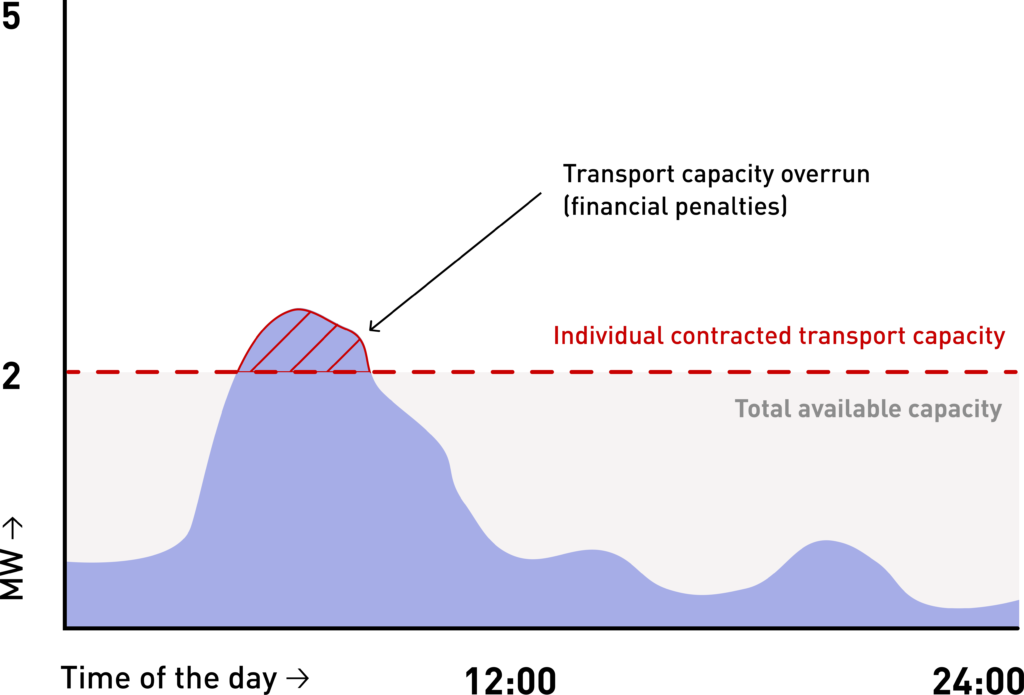
Collective capacity
This time, the participant joined a group contract. You can see the aggregated capacity usage of the participant (in purple) and its neighbors (in blue and orange), as well as the new collective capacity limit (red line). As the participants coordinate their usage (make sure to not peak at the same time), they manage to stay within their collective limits.
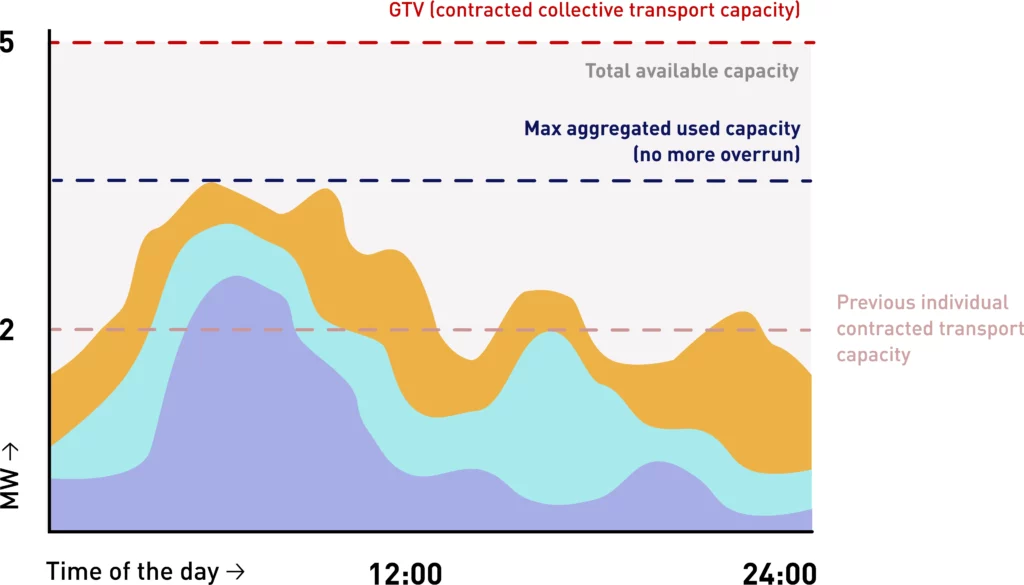
Currently under development and expected to be available by 2025*, the group TO aims to facilitate the collective management of energy resources and capacity among participating companies. However, the preparation for a group TO involves significant coordination among businesses to align on their capacity use.
*The law currently does not allow a participant in an energy hub to share their ‘transport rights’, this has still to be adjusted in the Grid Code, the set rules for grid operators.
Collective Capacity Limiting Contract (C-CBC)
Capacity Limiting Contracts (CBCs) are already available in many regions and are particularly useful to grid operators for managing congestion.
A CBC is an agreement with the DSO where the connected party commits to reducing their electricity take-off or feed-in during peak times in exchange for a fee, thereby helping to mitigate grid congestion. The fee is calculated based on the party’s missed generation or consumption.
This contract can be applied to an individual party, or in the case of EHs, to a group (referred to as a “Collective CBC”). The hub will then be given a collective capacity limit that can be reduced during peak times.
This limit can be:
- Fixed – The hub needs to reduce transport capacity during certain pre-agreed periods, such as evenings in the winter or daytime in the summer.
- Dynamic – The capacity limitation is only activated by the grid operator if it expects congestion to occur in the area of the connected party. Communication takes place via GOPACS or email, and the party must be represented by a CSP.
A collective CBC becomes particularly beneficial when the EH has numerous flexible assets or processes, such as controllable PV panels, batteries, heat buffers or charging infrastructure. It’s also preferred by producers rather than consumers, as cutting production and estimating the cost of missed generation is easier (due to market price indicators) than reducing consumption (which is usually less flexible) and estimating the associated loss.
Thus, the feasibility of a group CBC depends on the local grid conditions and the flexibility of the consumption patterns among the participating companies. Achieving this requires a thorough understanding of the local grid’s topology and continuous communication with the grid operator to ensure compliance.
3) How are energy hubs controlled and optimized?
The control and prioritization of energy flows within an energy hub are determined by the participants and formalized in a Participant Agreement.
This agreement outlines how the contracted capacity is shared among participants, along other terms such as tariff structure, the use of flexible assets etc.
Merit order
In theory, a merit order is established in the Participant Agreement to prioritize which flexible assets will be activated or curtailed first when the hub needs to reduce its feed-in, and which assets or loads will be prioritized when additional power and/or capacity is available. This merit order can vary depending on the timeframe.
Participants decide how the merit order is structured. It can be:
- Dynamic – Prioritization is based on the highest bids (e.g., “Company A and B are both willing to curtail their PV output this afternoon for a certain amount of money. The most advantageous bid wins.”)
- Pre-defined – Prioritization based on other criteria such as which assets are the most “critical for business”, who produced the power, etc. In this case, prices are usually pre-defined.
- A mix of both
Then, a common system called Energy Management System (EMS) aggregates available power together, monitors the collective capacity limit, determines priorities based on the merit order and optimization algorithms, and distributes power and/or capacity among participants. At the end of the month, the system will give data about production and usage of each company, and they will receive a fee for making or using available power and/or capacity. It is usually more transparent than traditional trading systems.
Finally, there is sometimes a possibility to sell an aggregated ‘surplus’ of energy or flexibility on balancing or congestion markets. However, it depends on agreements and whether or not participants are affiliated with the same energy trader.
How does a Hub EMS work?
The hub’s Energy Management System (EMS) must handle the data related to each participant’s production or consumption, monitor the collective fixed or dynamic capacity limit, optimize the flows depending on the merit order, and control the different assets.
To manage these complex functions, the EMS is typically divided into two parts:
1. On-site EMS / local controller
The on-site EMS (also called local controller) consists of a gateway box connected directly to the generation units, storage systems, consumption points and metering points. It reads-out data from the different meters, communicates this data to the cloud EMS, receives back control commands and controls the different units.
It also serves as a fallback in case connectivity to the hub EMS is lost. In some cases, it can also optimize flows “behind-the-meter”.
The Teleport: your local controller for energy hub assets
Are you looking for a gateway to remotely control the assets of your energy hub?
With the Teleport, you can connect all the assets in a fast, secure and scalable way, and integrate seamlessly with your Hub EMS.
2. Hub EMS
This cloud software receives the real-time measurement data from the on-site EMSs. It uses complex algorithms to ensure the hub remains balanced within collective capacity limits, optimizes energy distribution, and prioritizes renewable energy. The cloud EMS also considers the merit order and sends control commands to steer assets as needed.
The software is also capable of running simulations using external data, such as energy market prices or weather forecasts, to proactively manage energy and avoid peak loads. Additionally, it includes dashboarding and monitoring features to track and visualize the energetic and financial performance of the energy hub.
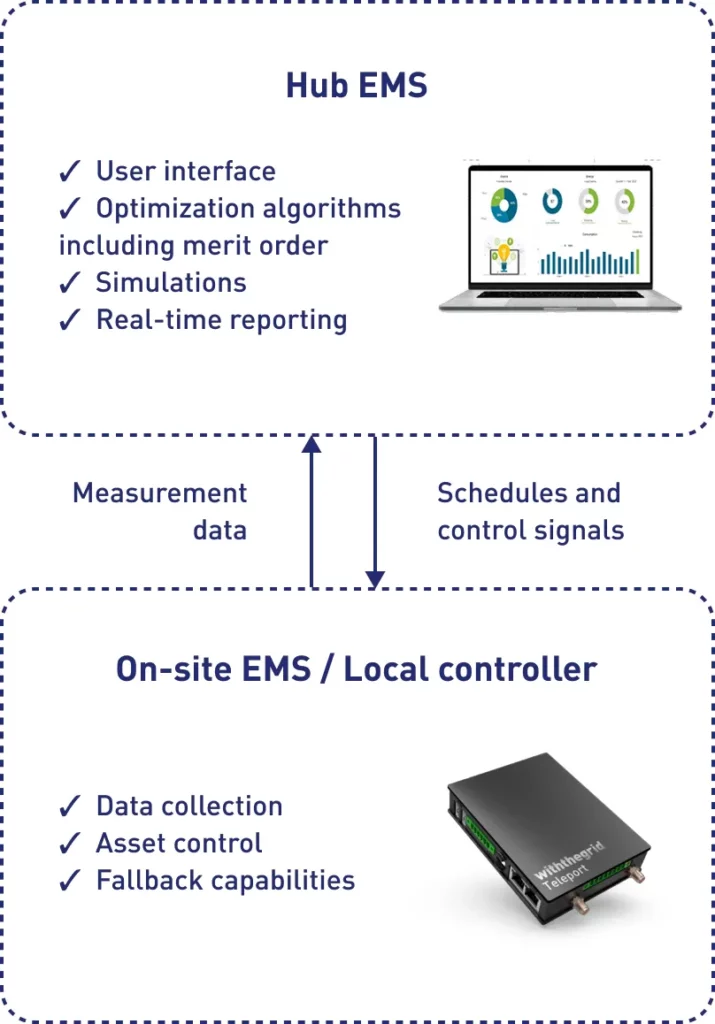
III. Case studies
Pannenweg Business Park
One of the first energy hubs in the Netherlands has been operational at Bedrijvenpark Pannenweg in Nederweert. Here, 20 companies share electricity amongst themselves, alleviating the strain on the main grid. The companies trade electricity at predetermined prices, with any shortages or surpluses managed through market trading via the OM | Nieuwe Energie self-supply platform.
Each asset and meter is connected to a Teleport (on-site EMS), which provides real-time data on energy usage and production while monitoring the combined grid limit. Continuous production is allowed as long as other hub members consume the electricity or if a battery can store the excess power for future use. As a result, companies are no longer dependent on their individual static limits.
Energy Cooperative Amsterdamse Haven (ECAH)
In early 2024, several companies operating in the Port of Amsterdam subscribed to a Capacity Limitation Contract (CBC) to use available capacity when the grid isn’t full. According to the Port of Amsterdam, this arrangement allowed 29 companies previously on a waiting list to connect to the electricity grid in the Western port area.
These individual CBCs were then integrated into a Collective CBC, managed by the Energie Coöperatie Amsterdamse Haven (ECAH). According to the grid operator Liander, this is the first flexible group contract established under the new congestion management regulations of the Netherlands Authority for Consumers & Markets.
The creation of this energy hub allows the participating companies to share responsibilities and coordinate their energy consumption, while the umbrella cooperative ECAH facilitates the collaboration. The hub is controlled via multiple Teleports on-site, and a shared energy management platform that ECAH is currently developing.
Additionally, the hub model allows for the exchange of electricity within the group, and the costs for necessary investments can be shared collectively.
IV. Conclusion
In conclusion, the development of energy hubs in the Netherlands represents another step towards creating a more resilient, decentralized, and sustainable energy system.
By fostering local cooperation, optimizing energy use, and enhancing flexibility, these hubs can play a role in helping businesses grow despite limitations brought by grid congestion.
As energy hub pilot initiatives emerge, the lessons learned and the evolving legal frameworks will likely pave the way for broader adoption, positioning energy hubs as a new tool to support the Netherlands’ energy transition.
✏️ Final note from the author
It’s important to keep in mind that this type of energy hub is still new in the Netherlands. Definitions, contracts, processes and technologies involved are currently still in development, and their impact on the grid and on congestion are still unknown. Thus, this article describes how an energy hub should work in theory, but it’s likely to evolve over time.

Want to unlock and control the assets of your energy hub?
Withthegrid and its partners can help you realize an energy hub. Start the conversation with our team today!
